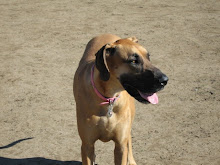The Great Dane combines, in its regal appearance, dignity, strength and elegance with great size and a powerful, well-formed, smoothly muscled body. It is one of the giant working breeds, but is unique in that its general conformation must be so well balanced that it never appears clumsy, and shall move with a long reach and powerful drive. It is known as the Apollo of dogs. A Great Dane must be spirited, courageous, never timid; always friendly and dependable. This physical and mental combination is the characteristic which gives the Great Dane the majesty possessed by no other breed. It is particularly true of this breed that there is an impression of great masculinity in males, as compared to an impression of femininity in females.
Characteristics
The male should appear more massive throughout than the female, with larger frame and heavier bone. In the ratio between length and height, the Great Dane should be square. In females, a somewhat longer body is permissible, providing she is well proportioned to her height. Coarseness or lack of substance are equally undesirable. The male shall not be less than 30 inches at the shoulders, but it is preferable that he be 32 inches or more, providing he is well proportioned to his height. The female shall not be less than 28 inches at the shoulders, but it is preferable that she be 30 inches or more, providing she is well proportioned to her height.
Owning
Great Danes can make great family dogs but require a lot of companionship and attention.
Temperament
The Great Dane must be spirited, courageous, always friendly and dependable, and never timid or aggressive.
Did You Know
The Great Dane was developed in Germany to hunt wild boars. The earliest written description of a dog resembling the breed may be found in Chinese literature of 1121 B.C. (an article by Dr. G. Ciaburri, Great Dane Club of Italy publication, 1929). The name of the breed (in the English language) is a translation of an old French designation, grand Danois, meaning "big Danish." This was only one of half a dozen names which had been used for centuries in France. Why the English adopted the name "Great Dane" from the French is a mystery. In 1891 the Great Dane Club of Germany adopted a precise standard, or official description of the ideal specimen.
This article was taken entirely from Yahoo!Pets
dog health
Saturday, March 15, 2008
Subscribe to:
Post Comments (Atom)




No comments:
Post a Comment